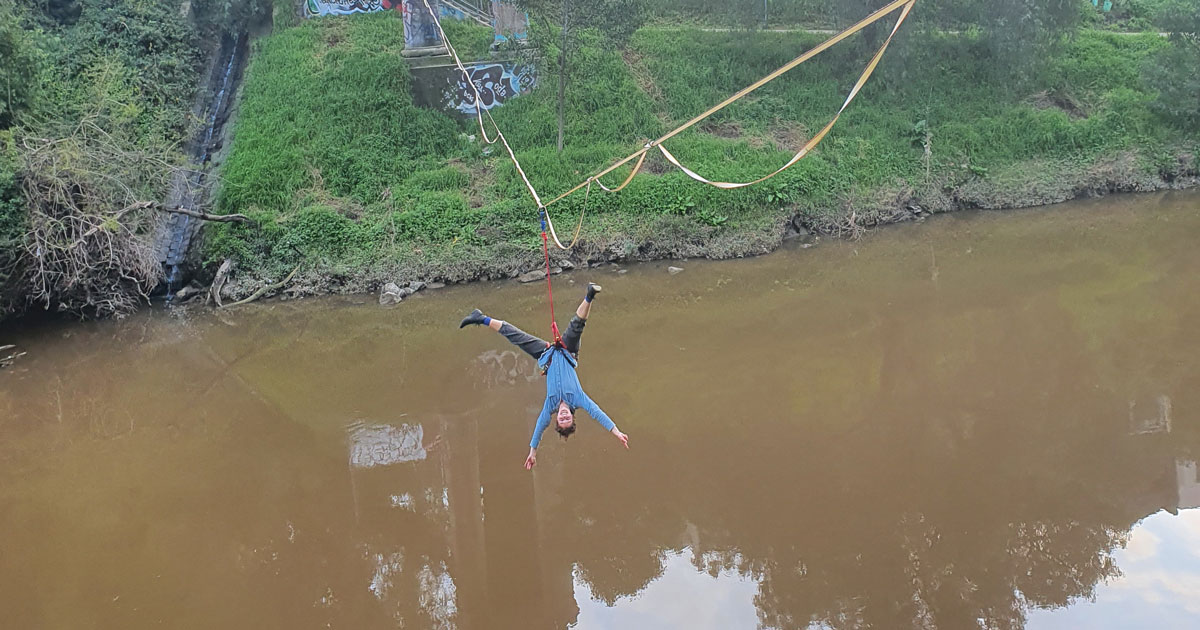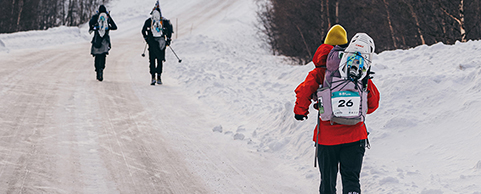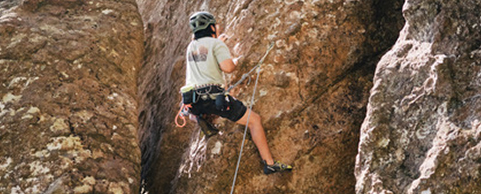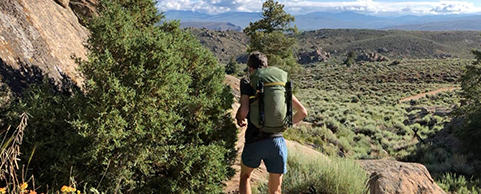Slacklining: Getting Better

Great! You can confidently stand up on both legs in a controlled way! Well done! You have made it further than most already. The instructions below assume you are walking on a line that has lateral movement above a few centimetres, which includes every set up EXCEPT high-tension 2-inch ratchet lines. If you are struggling to feel comfortable on the line or can only walk super-tight lines (lines that go 'twang'), read my previous article on what I'd call 'Step 1' HERE.
Step 2: Walking
- “Stand”: Begin by standing on the line and hold for 10–20 seconds.
- “Transfer”: Transfer your weight onto your front foot gradually.
- “Step”: When you feel confident, step your back foot in front of your other foot.
- Transfer your weight to return to “Stand”.
Troubleshooting
- Keep your gaze forward and not down. The line will always be exactly in front of your standing foot.
- Have your hips facing forwards and not to the side. This may happen more on one side.
- Keep your toes pointing forward and avoid turning your feet out. Position the line from the middle of the heel to your second toe.
- Weight Transfer:
- “Stand” with your weight distributed 50/50 between your front and back foot
- Taking a step: Gradually transfer all your weight to your front foot before taking a step. When your other foot makes contact with the line, transfer weight distribution back to 50/50.
- Be confident in the front foot you are weighting before you commit to the step.
- Keep both feet on the line: AVOID hovering your other foot off the line unless you are on a tight line or you can already confidently take steps. This is often more difficult if the line is loose (and potentially dangerous if you are still figuring out how to walk on a line).
- Aim to make corrections with your arms and not your hips.
- Smaller, slower movements are better.
- If you find yourself frequently “missing” the line, practice walking in a straight line on the ground without looking at your feet or with your eyes closed.
Focus on how everything is feeling while you are doing it rather than aching to “send”. If you can walk to the other side, great! But do not let this be the only goal you are focused on. Take good, solid steps and the send will come.
Step 3: Challenging Yourself.
*Note! This step is interchangeable with Step 4, 'Making the Line More Difficult'.*
Let’s make things tricky.
The following is a list of things to try if you want to make things more difficult. In order of mild to spicy:
- Walk with just one arm up, then the other.
- Take steps as slowly as you can. This might mean keeping your foot off the line for a few seconds before putting it back, then pausing once you have both feet on the line. Do this only when you can take steps confidently.
- Take steps backwards. It’s surprisingly easy and not as difficult as turning around. The line will always be exactly behind your other foot.
- Change your focal point. Try taking steps while looking up, to the left, right, down or even over your shoulder.
- Drop both arms. This is difficult. Transition from having one arm up. Hold for 10 seconds and when you are ready, try taking steps.
- Send the line: The moment you have all been waiting for. Go on. Walk the line without falling. You are ready.
- Endurance: Try walking and standing on the line for as long as possible. Train this gradually, because the muscles in your body will need recovery to keep up with your will to push for longer times. Use a song for reference if you get bored.
- Walk the line quickly: Keep your technique good and focus on being able to walk it well rather than walking so fast that you fall.
- Sit on the line: If you skate/snowboard/surf with your right foot forward (goofy), sit on your left buttcheek. If you are regular or are unsure of stance, sit on your right buttcheek. Position the line between your legs, but off to the one side (just above the junction of your cheek and leg). Have your hips facing slightly off to the side and bring the outside of the shin on your back leg (cheek side) on the line as if your are crossing one of your legs. Bring your arms up and hover your front foot off the ground. Take your time. This will teach you how to use only your arms to balance. This skill will carry over to your balance while walking. It is possible to learn this by yourself, but much better to learn with someone giving tips in person.
- Sit-start, Chongo or Drop-knee Mount: It is difficult to teach yourself these. More on this below.
- Exposure training: Exposure is a pose that involves facing out from the line, looking perpendicular to the trees/anchors. It is a great way to transition to turning around on the line in a slow and predictable way. Be patient with this, because falling backwards may result in a nasty thud. Learning exposure is therefore best when broken down step-by-step:
- Warm up! While on the ground, stand up on your tippy toes. If this is really easy, do it with your eyes closed. You can also try doing this on just one foot, then the other.
- To begin, stand up on the line. For now we will assume your left-leg is forward. Turn your back foot to the right so that it is at a right angle to the line. Position the line just below the ball of your right foot. Fall to the right side if you do and do not fall to the left in this orientation.
- Turn your shoulders so that your right arm is pointing in the same direction as your right foot. Keep your gaze steady for this step. Fall forward if you do.
- Turn your head to the right and quickly focus on a piece of the ground or other stationary object around 5–10 metres away from the line. I like to think of this position as “half-exposure” and it is a great way to train one side of your body to get used to activating muscles that operate your body forwards and backwards rather than just from side to side. Repeat these steps 1–4 with the other leg before attempting the next step.
- Turn your left foot to the right, positioning the line just below the ball of your foot. Keep your arms forward and if you fall, fall forwards not backwards.
- Finally, turn your left arm and shoulder to follow the rest of the body. It is important to follow the gradual transition into exposure due to the potential for serious injury from falling backwards onto your head or back. Exposure trains a whole new set of muscles and is my favourite position hold on all slacklines between trees, mountains and over water. A bonus trick can be to drop an arm, then the other, then both. Juggling, playing musical instruments, brushing teeth, eating a sandwich, the macarena and other dancing have all been done in exposure. Try one of these or something else if you feel like it. Keep your weight forward.
- Exposure “Crab Walks”: Take steps while in exposure. Like walking in a standard orientation, be confident in the foot you are weighting before you “slide” the other foot along the line. Fall forward if you do and practice walking in both directions.
- One-foot exposure, then “Pirate Exposure”. Attempt this only when your exposure is rock-solid. This is extremely difficult. Begin in exposure and slowly transfer your weight onto one foot before taking the other off the line. Let’s say we now have only our left leg on the line. Slowly bring your right foot behind your left knee and grab it with your left hand. Use your right hand to counterbalance and as usual, keep your weight forwards and fall forwards not backwards.
- Surfing a line. This is harder than it looks and can really hurt if you push too hard. The best slackliners in the world benefit from training this and many still find it difficult. I worship anyone who can make it look easy:
- On a loose line, find a stance that you are comfortable with. Slowly use your shoulders, hips and knees to purposefully sway the line from side to side like a pendulum. Think of it like pushing yourself on a swing, only you cannot hold onto anything with your arms. Timing and how hard you transfer your weight are the most difficult elements here.
- The best advice I can give for this is to focus on maintaining a smaller surf for longer rather than seeing how high you can go. This is best done on a *rodeo-line (*explained below), although some prefer to do it on lines with higher tension adding more of a “bounce”.
- Take steps mid-surf and try having the other foot in front if you are game. This is very difficult.
- Exposure surfing is difficult and dangerous, but looks and feels amazing. Like above, please take your time with this.
- Final challenge: Walk the line blindfolded.
- For this, practice walking the line during twilight. As the light decreases in the sky, you will notice your depth perception weakening and the advantage of vision will be less reliable. I find this is done most easily on short (10–15m), loose lines.
- If you can walk the line at night, try closing your eyes for a few seconds, increasing the period each time you attempt it. When the time is right, take out your makeshift blindfold and experience a heightened sense of body awareness and presence that is hard to match.
- Make small goals for yourself (eg. step, hold for 5 seconds, repeat 4, 6, 8 times. Then step, hold for 10 seconds, repeat 4, 6, 8 times).
- Blindfolded exposure is another great challenge. This, and all other blindfolded tricks will take a few practice sessions for them to be even slightly comfortable. If you can surf blindfolded then you have attained mastery in slacklining and salute you on behalf of the slacklining community.
Step 4: Making the Line More Difficult
Our aim is to make the line longer, looser or both.
EXAMPLE: An 8m long line with anchors 80cm off the ground is too easy for you. You have three options:
- Change the anchor height: This length can stay at 8m but we can move the anchors up to 100cm, 120cm or 160cm in height. This makes the line Looser.
- Change the length and anchor height: We can change the length of the line to 16m and bring the anchors up to 160cm. This keeps the same tension but makes the line Longer.
- A slight change in length and/or anchor height: A mix in between the two. For example, a 9-metre line that has 120cm (as opposed to 8 metres and 80cm). A more realistic option because it allows you to be creative with the anchors that are available to you. Depending on your variation, this makes the line Longer and/or Looser.
In all of these steps, the line may feel “heavier”, “slower”, more “powerful” and/or have greater lateral movement. They will also physically demand more strength and stability from the muscles you are using. Be prepared to fatigue, take breaks and call it a day before you injure yourself.
Remember to make sure the line is no higher than mid-shin height in the middle.
Since these steps often involve bringing the anchors higher, before attempting to send on a line that challenges you, it is best to start in the middle first. (This is also explained in my previous article.) Never feel as though you have to walk beyond a point you would feel OK to fall. As the lines get longer, the anchor height gets higher. Here, it is best to find natural “bowls” or “dips” between anchors you use for lines above 30 metres. Or simply, do not walk that final 10-30% of the line. No one is judging you for avoiding potential injury. If you feel like it’s a send, then it’s a send. This is also the general consensus among the Aussie slacklining community. Let’s keep this pursuit of intrinsic achievement positive.
Slacklining has an unusual progression. With most skills, the first level you learn is a piece of cake once you have attained proficiency. If you started on short, tight lines and are now walking a longer “rodeo” or even “transition” line, a short, tight line will demand a fairly different pattern of balance. In slacklining, we get good at what we do most. However, the skill transfer between length and tension has a negative correlation. That is to say, loose lines better equip you for long lines that are either loose or tight. This has a lot to do with how much lateral movement is possible below you. For a looser line, your upper body need not have to “pivot” anywhere near as much as it has to on a tight line. The loose line may move beneath you, but your centre of gravity and therefore balance need not have to. You have learned to accept some movement underneath you rather than always fighting it. Conversely, on a short, tight line (ones that go 'twang'), it is common to counterbalance with a foot off the line and pivot the torso a lot from side to side.
Troubleshooting
If a challenge is too great, find a middle-ground between the two difficulties. For example, from 10m length and 1m height, go to 12m length and 1.2m height then a 12m length and 1.5m height rather than 30m length and 3m height. This is also a great way to feel incremental progression every time you slackline. The maths behind this doesn’t have to be perfectly in proportion. The more different lines you walk, the faster your body will adapt to new lengths, tensions and even characteristics specific to different kinds of slackline webbings. Eg. high-stretch nylon vs low-stretch polyester. This ability to adapt is invaluable with slacklining as it can allow you to vary between a rodeo-line, a tight line, a long line and everything in-between, rapidly accommodating to the behaviour of each one.
Level Up with Rodeo Lines
Rodeo lines are slacklines with very little or no tension. They have very high anchors relative to their length: for example, a 5m line with 3m high anchors or 15m with 4m high anchors. These lines should still remain less than half a metre off the ground (when someone is on the line) to reduce the risk of injury. There is a focus on being in the middle rather than sending, especially because only a small proportion of the line can be walked.
Rodeo lines are quite difficult and offer excellent, efficient training for those who want to make the step from intermediate to advanced and beyond. These patterns of balance formed from being on rodeo lines immensely help on all slacklines that aren’t tight and short. To put it lightly, you cannot make mistakes on a rodeo or it will throw you off. For most rodeo lines, the higher the anchors, the greater the difficulty, although length and webbing also can mix things up. Try rigging and training on different rodeos to feel the difference for yourself.
Focus on keeping your legs and core strong from the second you step on the line (do so slowly). Only make very small movements with your arms. Be prepared to learn how to walk again. Balance is not only left and right, but now forwards and backwards too.
“YOU MUST BE THIS TALL TO RIDE THE RODEO”: Only attempt a rodeo line when you can easily walk a line with similar length and anchor heights. Work your way up to it. For example, if a 10m line with 2m high anchors is comfortable for you, raise the anchors to 2.5m height, then 3m height instead of going straight to 4m in height. DO NOT let a beginner ride the rodeo as this will likely result in injury.
Train STEP 3 and STEP 4 Simultaneously
As mentioned in STEP 3, STEP 4 can be interchanged with STEP 3 and it is great to practice different skills on lines you find more challenging. STEP 4 is potentially infinite depending on what anchors and gear you have access to. For lines up above 25m, there are many different rigging options to upgrade to depending on what your goals are and it gets a bit complicated. Get in touch with a slackline retailer or the slackline community to find a setup that will accommodate your goals. It is tricky to self-educate on this and doing so may result in spending large amounts of money on gear you may not use or needing to buy more gear after finding out the setup you chose doesn’t quite work for you.
Take Breaks, Know your Limits
One final point is to take frequent breaks when training. Slacklining activates many stabilising muscles that are often unconditioned. Slacklines have a habit of finding these muscles wherever they may be and punishing you when they are fatigued or weaker than they could be. Like all muscles, stabilising muscles require warming up and rest after being asked to do something that they are not used to. It is beneficial to take frequent 2–5 minute breaks for both your body and mind to recover, especially if you are feeling tired or flustered. Please avoid injury by knowing when to call it a day! It will make it that much more rewarding when you set up your line next time. Enjoy the process of learning a new skill and remember to have fun!
You will feel sore the following couple of days after a training session, like you would after going to the gym. The most common muscle groups that tend to feel sore are often your obliques and muscles around your ribs as well as your shoulders, hips, lower back, ankles and thighs. This will lesson once your body becomes used to slackline-specific movements, although expect to still feel sore after heavy training. Since slacklining requires more muscle strength and endurance rather than flexibility, I've found that heavy stretching before or after a session is not necessary and may just be asking more of the muscles you have already fatigued. Light stretching before and after has always helped me personally, though. I’m not sure why there is an implied necessity to be highly flexible for slacklining, but many people have found forms of yoga to benefit them on days off. I prefer pilates to supplement slacklining as there is more focus on strength while still practising conscious, deliberate breath and movement.
Sit-Starts, Chongo and Drop-Knee Mounts
If you are on a line over water, mountains, or even one at the that is just a little too high to stand up on when there is no one on it (often lines 25m+), you will need to know how to get up from a seated position. The three main methods of doing this are the “Sitstart”, “Chongo” and “Drop-Knee” (my preferred) mounts. I will not be able to teach these here as there are simply too many mistakes that are possible to troubleshoot. Your best option for learning these is to reach out to the slacklining community in your city. Individuals within this community will be able to provide real-time feedback on your mounting (and walking) technique as well as figure out which one of these mounts best suit your body. There are contraindications with all mounts, especially the Chongo, which may damage your knee(s) if not done correctly or without appropriate strength and flexibility. There are (sometimes questionable) educational resources on YouTube, but your best option if possible is to learn with an experienced slackliner.
How to Get Into Highlining
Here is a Skill Checklist that a slackliner MUST HAVE before attempting a highline:
- Walk a 30m line.
- Easily sit on the line for a minute or more.
- Sit-start, Chongo, Drop-knee or other mount achieved 80% of the time or more. This is the most common difficulty faced on a highline.
- Mount the line from underneath.
- Climb a leash.
- Tie a threaded Figure-8 knot.
- Have access to a harness, PAS and Hangover or Rollex (roller carabiner).
Reach out to the slackline community in your city. Facebook has groups for every major city and one for many smaller cities too. If you are close to ticking off this checklist, find people who are better than you and can give you tips on completing it. Every highliner that I know, including myself, finds it rewarding to take out first-time highliners, especially if you have done your homework. Just ask.
Join the Australian Slackline Association (ASA) if you can too as they do the legal grunt work to make sure you are not asked to leave when doing the right thing, whether it’s between trees, over rivers or between mountains. Membership is cheap and also offers benefits to many outdoor retailers so that you can save a few dollars too.
See our range of climbing gear.
More Articles


















